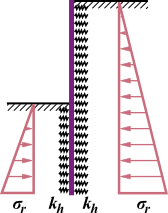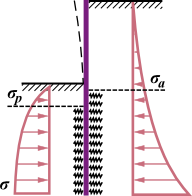Method of Dependent Pressures
The basic assumption of the method is that the soil or rock in the vicinity of the wall behaves as ideally elastic-plastic Winkler material. This material is determined by the modulus of subsoil reaction kh, which characterizes the deformation in the elastic region and by additional limiting deformations. When exceeding these deformations the material behaves as ideally plastic.
The following assumptions are used:
- The pressure acting on a wall may attain an arbitrary value between active and passive pressure - but it cannot fall outside of these boundaries.
- The pressure at rest acts on an undeformed structure (w = 0).
The pressure acting on a deformed structure is given by:
![]()
σ = σa for: σ < σa
σ = σp for: σ > σp
where: | σr | - | pressure at rest |
kh | - | modulus of subsoil reaction | |
w | - | deformation of structure | |
σa | - | ||
σp | - |
The computational procedure is as follows:
- The modulus of subsoil reaction kh is assigned to all elements and the structure is loaded by the pressure at rest - see figure:
 Scheme of the structure before the first iteration
Scheme of the structure before the first iteration
- The analysis is carried out and the condition for allowable magnitudes of pressures acting on the wall is checked. In locations at which these conditions are violated the program assigns the value of kh = 0 and the wall is loaded by active or passive pressure, respectively - see figure:
 Scheme of the structure during the iteration process
Scheme of the structure during the iteration process
The above iteration procedure continues until all required conditions are satisfied.
In analyses of subsequent stages of construction, the program accounts for plastic deformation of the wall. This is also the reason for specifying individual stages of construction that comply with the actual construction process.
Literature:
Bartak, J.: Progresivni postupy navrhovani pazenych stavebnich jam. VUT Brno, 1991.
Hurych, P.: Metoda zavislych tlaku. Sbornik konference "Automatizacia projektovania", Vysoke Tatry, 1978.